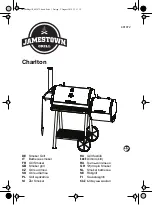
The cooker has been designed to provide a satisfactory
supply of domestic hot water with or without a limited
amount of heating with a normal day’s cooking providing
the cooker is kept alight overnight and the system
complete with lagged cylinder conforms to the installation
instructions.
In some circumstances it may be possible to overheat the
appliance and the water inside will boil. This will be evident
by the sound of a knocking noise coming from the
appliance and pipes around the house. If this occurs, close
off all air controls and manually start the central heating
pump if fitted. Opening the oven doors and hotplate covers
will help to release heat from the appliance. Be aware that
steam and boiling water will be expended from any open
vent from the heating system probably in the roof space at
the expansion tank.
WARNING:-
If there is a possibility that a part of the
heating system may be frozen you should not light the
stove until you are confident that the system is free of ice,
has no leaks and water is able to fully circulate.
Always use a qualified service/heating engineer when
servicing is required. Use only authorised replacement
parts. Do not make unauthorised modifications.
To Replace Grate Bars
1. Dump the grate assembly as described in
1
,
2
and
3
under ‘To Dump the Grate - Clinker Removal’.
2. Lift up and draw forward the firebar in question and
replace new firebar in reverse manner.
To Replace Grate Bar Support Frame
1. Dump the grate assembly as described in
1
,
2
and
3
under ‘
TO DUMP THE GRATE - CLINKER
REMOVAL
’.
2. Lift up and withdraw all the grate bars from the cooker.
3. Lift the support frame from its rear pivot support and
withdraw until clear of ashpit.
4. Insert new frame ensuring its pivot/supported at rear.
5. Replace firebars ensuring they are in correct order.
6. Lift grate assembly (as described in
4
and
5
under ‘
TO
DUMP THE GRATE CLINKER’.
Building regulations require that when ever a new or
replacement fixed solid fuel or wood/biomass appliance is
installed in a dwelling a carbon monoxide alarm must be
fitted in the same room as the appliance. Further
guidance on the installation of the carbon monoxide alarm
is available in BS EN 50292:2002 and from the alarm
manufacturer’s instructions. Provision of an alarm must
not be considered a substitute for either installing the
appliance correctly or ensuring regular servicing and
maintenance of the appliance and chimney system.
WARNING:-
Your installer should have fitted a CO alarm
in the same room as the appliance. If the alarm sounds
unexpectedly, follow the instructions given under
“Warning Note” above.
Properly installed and operated, this cooker will not emit
fumes.
Occasionally fumes from de-ashing and re-fuelling may
occur, but persistent fume emission must not be tolerated.
If fume emission does persist, then the following
immediate action should be taken:-
a) Open doors and windows to ventilate room.
b) Let the fire out or remove lit fuel from cooker.
c) Check for flue or chimney blockage and clean if
required.
d) Do not attempt to relight the fire until cause of fumes
has been been identified, and if necessary seek
professional advice.
If the stove is to be left unused for a prolonged period of
time then it should be given a thorough clean to remove
ash and unburned fuel residues. To enable a good flow of
air through the appliance to reduce condensation and
subsequent damage, leave the air controls fully open.
It is important that the flue connection, any appliance
baffles or throat plates and the chimney are swept prior to
lighting up after a prolonged shutdown period.
Part Number
Description
No Req’d
RS4M 22093
Bottomgrate Bars Top
4
RS4M 22094
Bottomgrate Bars Bottom
3
RS4F3-13507
Oven Side Firebricks (Fixed)
2
RS4F4-13508
Firebox Side Top Firebrick
1
RS4F3-13509
Front Firebrick
1
RS4F3-13507
Boiler Side Firebricks
2
(Removeable)
RS1M91905
Ashpan 2
RSFM61
Operating Tool
1
Replacement parts if required are available from your
local stockist.
9
SERVICING
FUME EMISSION WARNING
CO ALARM
HOT WATER SERVICE
PROLONGED NON USE
SPARES LIST
Fig. 15






































